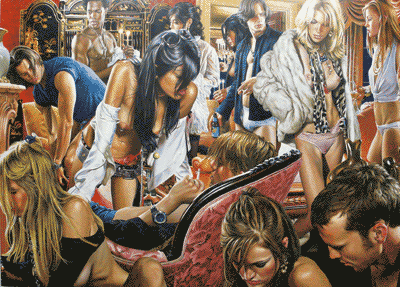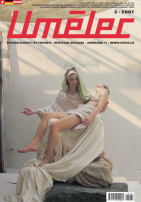|
Weaving through the crowds at Art Basel 2007, you catch a glimpse of the entire artistic universe of the last one hundred years. Amidst all of the fanfare a new trend has definitively emerged: hypertrophy. Sales figures are increasing, the crowds of visitors are growing, parallel events are mushrooming; and riding in the slipstream of Basel new fairs emerge every year that want to benefit from the current buying frenzy. At Art Basel, both the journalist and the curator seem to be most concerned with highlighting the galleries that are already establishments unto themselves. They become participants in the spectacle, swept up by the distinct social atmosphere of the event and its ability to cultivate a desire for big name artists with signature styles. At times the Art Basel makes you feel like you’re taking part in an arty quiz night, a ‘Whowants- to-be-an-art-millionaire?’ competition that tests your knowledge of all the players in the contemporary art world. In this game fame is rewarded; those that are the loudest emerge as the winners. As you wander around, there is a second-market Schiele here, a second- -rate Picasso there, three-slit Fontanas, lots of Warhol leftovers; an Andre is lying around on the floor, a Judd has been screwed into the wall of a booth. A monochrome Damien Hirst with perished butterflies pops up, its gesture still powerful. Two years earlier though you could have seen the dead butterflies stuck on a pink heart, a work that was even better: more harsh and cynical. Opie comes up once again with sequences of lightly clad, street-walking women. You can’t help but become slightly melancholic when you see any number of artists who continue to copy an idea that made them famous twenty or thirty years ago. These are the ‘one-hit-wonders’ of the art market – people who reproduce their hits again and again for buyers who seek to stock their collections with familiar material. In any case, the buyer – I’m sorry, the collector – is part of the spectacle; and it is precisely this character that adds zest to the Art Basel. On First Choice Day, it is quite a scene to witness the multimillionaires crowding the courtyard and lining up for bubbles and bratwurst, perching on staircases and posing on the lawn, visibly worn out from the artistic drumfire. There is ample time to take a good look at the ‘trophy wives’ with their unconvincing face-lifts and designer outfits, equal parts extravagant and eccentric, until 6pm when the gates open to the pariahs. These pariahs, who have been invited to the official opening, enter only once the best deals have gone and the real elite crowd has fled to the hotel. Still, being invited to the official opening is much better than having to buy a ticket with the riffraff. Even on First Choice Day, however, there are subtle differences between people’s VIP status. What really matters is the number of evening dinners you’ve been invited to, and if the major gallery owners spot you and immediately drop everything in order to joyfully exclaim: Sara! Bob! Haemmerli! In comparison, no one would like to be in Lukas Mühlemann’s shoes. Mühlemann, the former head of McKinsey Switzerland and the fallen boss of the Credit Suisse Group, was co-responsible for the insolvency of the national airline Swissair, effectively turning the man into an untouchable in Switzerland. Bravely standing about in the courtyard, everyone pretends not to know who he is. Nobody, of course, wants to be seen with that sort of person regardless of how many Rauschenbergs he has bought. In short, the Art Basel’s function as a social event is at least as important as its function as an occasion for art shopping. Art features most importantly in the question: have you bought anything? The ideal answer should be “Oh, of course!” And for many it is, thus on the second day you come across plenty of happy gallery owners who are quick to reassure you, as the spectacle roars on behind them, that “things are going brilliantly!” This year the other topic on everyone’s mind was the question of who would succeed Sam Keller as director of Art Basel. Keller, who is set to take over the Museum Beyeler, catapulted the event into a new league when he established the Art Basel Miami Beach – a stroke of genius that enabled him to forestall a rival fair in the USA. Keller is perfectly suited to orchestrate Art Basel as he is acquainted with everyone who is anyone. Known as the life of the party, Keller runs on adrenaline and will probably keep his famed reputation as Mr. Art long after he is replaced. Three people are set to inherit his directorial position; another case of hypertrophy. The establishment of the Art Basel Miami Beach has had a surprising cross-marketing effect: since its establishment, more people have been traveling to Basel, not fewer. The emergence of more art fairs geared towards specific crowds is therefore an exciting, not daunting, prospect. Currently there is the List, a fair founded for off-galleries, and the Local Fair, for whose taste the List isn’t ‘off’ enough. For renowned galleries that do not quite make it to Basel, there are now Volta and Scope, and the Latin American fair scene centers around the Balentîna. At these fairs, there is a common complaint that at Art Basel “people buy anything” or that they “buy blindly.” This envy and fascination which surrounds the spectacle of Art Basel has led some artists to make Basel itself the subject of artworks. The paintings of the Chinese artist Zheng Guogu, for example, immortalize views of the fair, including its director Sam Keller. The Spaniard Eugenio Merino, in his vitriolic and taunting style, has created works that borrow from the corporate design of illuminated advertising signs of the Art Basel and the Art Basel Miami Beach.
Рекомендуемые статьи

|
|
Author dreaming of a future without censorship we have never got rid of.
It seems, that people don‘t care while it grows stronger again.
|

|
|
Contents of the new issue.
|

|
|
Nick Land was a British philosopher but is no longer, though he is not dead. The almost neurotic fervor with which he scratched at the scars of reality has seduced more than a few promising academics onto the path of art that offends in its originality. The texts that he has left behind are reliably revolting and boring, and impel us to castrate their categorization as “mere” literature.
|

|
|
Borrowing heavily from fairy tales, fables and science fiction, the art of Magda Tóthová revolves around modern utopias and social models and their failures. Her works address personal and social issues, both the private and the political. The stylistic device of personification is central to the social criticism emblematic of her work and to the negotiation of concepts used to construct norms.…
|
|









Комментарии
Статья не была прокомментированаДобавить новый комментарий